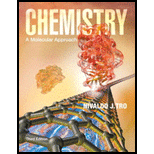
Q1. This graph shows the concentration of the reactant A in the reaction A → B. Determine the average

a) 0.07 M/s
b) 0.007 M/s
c) 0.86 M/s
d) 0.014 M/s
Introduction: The rate of change of concentration of products and reactants with respect to time is called the average rate of the reaction.
Answer to Problem 1SAQ
Correct answer: The average rate of the reaction is
Therefore, option (d) is correct.
Explanation of Solution
Justify reasons for the correct statement:
The average rate of the reaction is written as follows:
So,
Hence, option (d) is correct.
Want to see more full solutions like this?
Chapter 13 Solutions
Chemistry: A Molecular Approach
Additional Science Textbook Solutions
Organic Chemistry (9th Edition)
Organic Chemistry (8th Edition)
Chemistry (7th Edition)
Introductory Chemistry (6th Edition)
- Based on the diagram in Exercise 12.83, which of the reactions has the fastest rate? Which has the slowest rate?arrow_forwardIf a textbook defined a catalyst as "a substance that increases the rate of a reaction," would that definition be adequate?arrow_forwardConsider the hypothetical reaction A+B+2C2D+3E In a study of this reaction three experiments were run at the same temperature. The rate is defined as [B]/t. Experiment 1: [A]0 = 2.0 M [B]0 = 1.0 103 M [C]0 = 1.0 M [B] (mol/L) Time(s) 2.7 104 1.0 105 1.6 104 2.0 105 1.1 104 3.0 105 8.5 105 4.0 105 6.9 105 5.0 105 5.8 105 6.0 105 Experiment 2: [A]0 = 1.0 102M [B]0 = 3.0 M [C]0 = 1.0 M [A] (mol/L) Time(s) 8.9 103 1.0 7.1 103 3.0 5.5 103 5.0 3.8 103 8.0 2.9 103 10.0 2.0 103 13.0 Experiment 3: [A]0 = 10.0 M [B]0 = 5.0 M [C]0 = 5.0 101M [C] (mol/L) Time(s) 0.43 1.0 102 0.36 2.0 102 0.29 3.0 102 0.22 4.0 102 0.15 5.0 102 0.08 6.0 102 Write the rate law for this reaction, and calculate the value of the rate constant.arrow_forward
- Experiments were conducted to study the rate of the reaction represented by this equation.[2] 2NO(g)+2H2(g)N2(g)+2H2O(g) Initial concentrations and rates of reaction are given here. Experiment Initial Concentration [NO] (mol/L) Initial Concentration, [H2] (mol/L) Initial Rate of Formation of N2 (mol/L min) 1 0.0060 0.0010 1.8104 2 0.0060 0.0020 3.6104 3 0.0010 0.0060 0.30104 4 0.0020 0.0060 1.2104 Consider the following questions: (a) Determine the order for each of the reactants, NO and H2, from the data given and show your reasoning. (b) Write the overall rate law for the reaction. (c) Calculate the value of the rate constant, k, for the reaction. Include units. (d) For experiment 2, calculate the concentration of NO remaining when exactly one-half of the original amount of H2 had been consumed. (e) The following sequence of elementary steps is a proposed mechanism for the reaction. Step 1: NO+NON2O2 Step 2: N2O2+H2H2O+N2O Step 3: N2O+H2N2+H2O Based on the data presented, which of these is the rate determining step? Show that the mechanism is consistent with the observed rate law for the reaction and the overall stoichiometry of the reaction.arrow_forwardExplain what is meant by the average rate of a reaction.arrow_forwardA rate of reaction depends on four variables (Question 13.1). Explain by means of an example how the rate law deals with each of these variables.arrow_forward
- Consider the decomposition reaction 2X2Y+ZThe following graph shows the change in concentration with respect to time for the reaction. What does each of the curves labeled 1, 2, and 3 represent?arrow_forwardWhy awe elementary reactions involving three or more reactants very uncommon?arrow_forwardWhen every collision between reactants leads to a reaction, what determines the rate at which the reaction occurs?arrow_forward
 Chemistry by OpenStax (2015-05-04)ChemistryISBN:9781938168390Author:Klaus Theopold, Richard H Langley, Paul Flowers, William R. Robinson, Mark BlaserPublisher:OpenStaxChemistry: Matter and ChangeChemistryISBN:9780078746376Author:Dinah Zike, Laurel Dingrando, Nicholas Hainen, Cheryl WistromPublisher:Glencoe/McGraw-Hill School Pub Co
Chemistry by OpenStax (2015-05-04)ChemistryISBN:9781938168390Author:Klaus Theopold, Richard H Langley, Paul Flowers, William R. Robinson, Mark BlaserPublisher:OpenStaxChemistry: Matter and ChangeChemistryISBN:9780078746376Author:Dinah Zike, Laurel Dingrando, Nicholas Hainen, Cheryl WistromPublisher:Glencoe/McGraw-Hill School Pub Co Chemistry for Engineering StudentsChemistryISBN:9781337398909Author:Lawrence S. Brown, Tom HolmePublisher:Cengage Learning
Chemistry for Engineering StudentsChemistryISBN:9781337398909Author:Lawrence S. Brown, Tom HolmePublisher:Cengage Learning Chemistry: The Molecular ScienceChemistryISBN:9781285199047Author:John W. Moore, Conrad L. StanitskiPublisher:Cengage Learning
Chemistry: The Molecular ScienceChemistryISBN:9781285199047Author:John W. Moore, Conrad L. StanitskiPublisher:Cengage Learning Chemistry: Principles and ReactionsChemistryISBN:9781305079373Author:William L. Masterton, Cecile N. HurleyPublisher:Cengage Learning
Chemistry: Principles and ReactionsChemistryISBN:9781305079373Author:William L. Masterton, Cecile N. HurleyPublisher:Cengage Learning Chemistry for Engineering StudentsChemistryISBN:9781285199023Author:Lawrence S. Brown, Tom HolmePublisher:Cengage Learning
Chemistry for Engineering StudentsChemistryISBN:9781285199023Author:Lawrence S. Brown, Tom HolmePublisher:Cengage Learning





